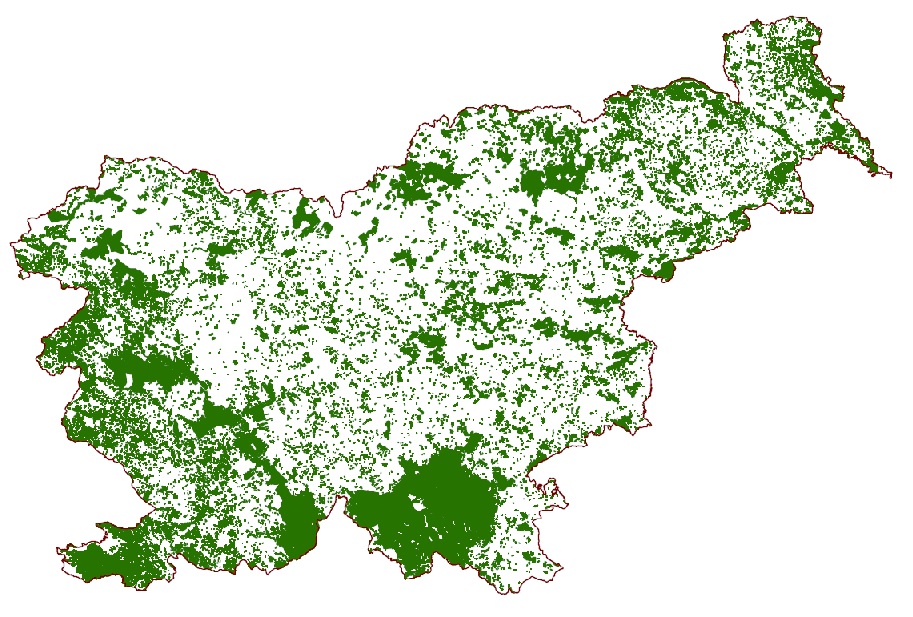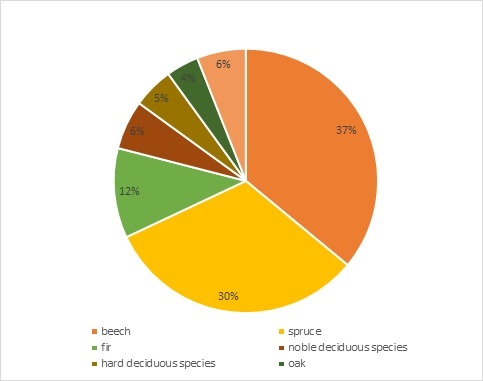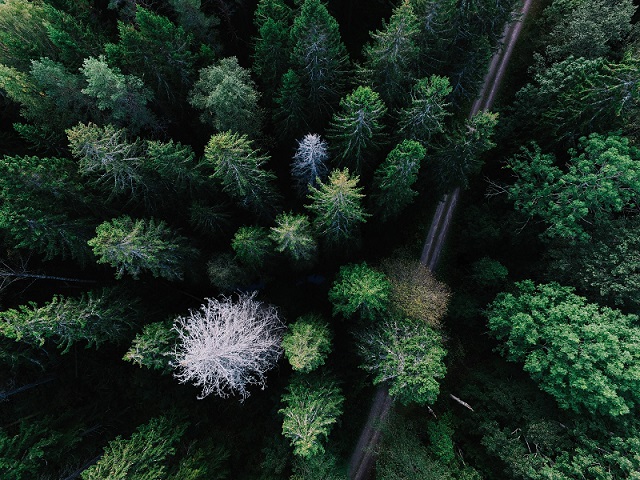|
CONTACT: SLOVENSKI DRŽAVNI GOZDOVI, d.o.o. A: Rožna ulica 39, 1330 Kočevje - SLOVENIA E: Ta e-poštni naslov je zaščiten proti smetenju. Potrebujete Javascript za pogled. |
Video presentation - State Forestry Company:
Establishment
The Republic of Slovenia is an owner of 236,400 ha (year 2019) of forests, i.e. approximately 20% of all forests in the territory of Slovenia. State forests cover almost 12% of the Slovenian territory (Figure 1). After 20 years of concessions in the state-owned forests, the Republic of Slovenia established the Slovenski državni gozdovi d.o.o. company (SiDG) with the purpose to manage the respective forests. The company was founded on the basis of the Management of State Forests Act (ZGGLRS). The SiDG company was established on 17 March 2016 by the Articles of Association of Slovenski državni gozdovi, d.o.o. (Articles of Association of SiDG). It began to pursue the respective activity on 1 July 2016. Its registered office is in Kočevje. The share capital of the company is EUR 22,440,000.

Figure 1: State owned forests managed by SiDG
The main objectives of managing state-owned forest are the following:
- Taking into account the principles of sustainable, multifunctional and forestry compatible management of state forests to achieve the highest possible rate of return and quality of timber assortments.
- Contribute to the establishment and development of forest wood chains, promotion of timber and timber products and creation of green jobs.
- Increase the area of state forests in the long-term.
- Contribute to the achievement of the objectives of rural development, in particular the preservation of agricultural and rural development in mountainous regions with limited management possibilities.
- Contribute to the achievement of objectives to preserve nature, in particular the objectives of Natura 2000 areas and protected areas.
- Provide training of professional staff and support education and scientific-research work in the fields of forest, forestry and wood processing.
- Implement the sale of standing timber to a minimum extent.
Description of state forests
An average growing stock of state forests is 324 m3/ha. Prevailing tree species in state forests are beech (37%) and spruce (30%). Other tree species with a significant share are fir (12%) and oak (4%). The remaining share includes noble deciduous species (6%), hard deciduous species (5%) and minority tree species (6%) (Figure 2).

Figure 2: Representation of tree species (ZGS, 2020)
SiDG is a holder of FSC and PEFC certificates for all respective forests.
Activities
The main activities pursued by SiDG are forestry, sale of forest wood products and logistics, management of real estate and acquisition of forests, wood processing and other activities for developing all other forest functions. Individual activities are described below in detail.
The forestry activity includes:
- Logging, skidding and transport of forest wood products,
- Construction and maintenance of forest infrastructure,
- Silvicultural and protection works and other tasks for providing all forest functions,
- Certification (FSC and PEFC),
- Participation in EUSTAFOR,
- Active cooperation in forest management planning,
- Executing all required and planned works in state forests.
The sale of forest wood products and logistics include:
- Selling of forest wood products from state forests,
- Organising the transport of wood products from state forests.
Real estate management and acquisition of forests comprises:
- Transactions related to forest (purchase, sale, trade, divisions) and unpaid transfers of forest ownership,
- Instituting easement, establishing rights of encumbrances and rights of superficies in state forests,
- Issuing consents for state forest leasing or leasing the buildings in forest.
The wood processing activity includes:
- Primary wood processing (Snežnik d. o. o., a subsidiary),
- Contributing to the establishment and development of forest wood chains by establishing centres for wood collecting and processing.
Organisation
Company’s bodies are assembly, supervisory board, management and expert panel.
The Slovenian Sovereign Holding performs tasks and has competence of an assembly.
The Supervisory board consists of 8 members, of which 5 representatives are chosen by the Republic of Slovenia while the company’s employees appoint 3 representatives.
The management comprises 2 members - Chief executive officers (CEO).
There are 10 members in the expert panel. The expert panel serves as an advisory body for the management. (Articles of Association of SiDG)
The company is divided to 6 divisions. Divisions cover fundamental activities pursued by the company. The main areas are forestry, sales and logistics, and hunting. However, the latter has not started to perform its tasks yet. Supportive divisions include the fields of finance, real estate and general affairs. At the top of the organisational structure there is the management which covers the fields of information technology, public relationships, quality assurance and internal audit (Figure 3).

Figure 3: Organisational chart of SiDG
The forestry division has 8 business units: Kočevje, Novo mesto, Postojna, Tolmin, Ljubljana, Celje, Ptuj and Maribor (Figure 4). Business units conduct main operational tasks in the field of forestry. Each business unit is further divided to forestry units. There are 34 forestry units in total.

Figure 4: Territorial organisation of SiDG
Subcontracting
The majority of works in state forests (harvesting, silvicultural and forest protection works, works for other forest functions, construction and maintenance of forest infrastructure) is subcontracted through public calls for tenders. Calls for tenders are designed to require framework agreements. Framework agreements currently apply for the period from 1 to 2 years. Only a part of harvesting and transport is currently carried out by own capacities, while the rest is subcontracted through public calls for tenders. Calls for tenders have two stages. In the first stage, all qualified contractors (tenderers) with adequate capacities (signing a framework agreement) are selected. The second stage includes applying for calls for tenders for actual projects, for which the contractors then bid on. A certain call for tenders may also include several different work sites, i.e. lots.
There are 4 framework agreements for subcontracting, i.e.:
- Harvesting,
- Silvicultural and forest protection (GVG),
- Wood transport,
- Forestry construction.


